Japanese barberry Berberis thunbergii f. atropurpurea

ABOUT
The plant commonly known as Japanese barberry is a striking shrub that is widely recognized for its richly colored leaves which are typically a deep purple hue. These leaves are often small and oval, with smooth margins, presenting a lush and dense foliage that can cover the shrub thoroughly. During the flowering season, the Japanese barberry produces small, yellow flowers that dangle in clusters. These flowers provide a beautiful contrast against the dark leaves, making the plant especially eye-catching in a garden setting. After flowering, the plant produces bright red berries that are small and oblong, often persisting on the branches well into the winter months. The berries not only add to the ornamental value of the shrub but also attract various birds and wildlife. The branches of the Japanese barberry are typically thin and may have sharp thorns, adding a layer of texture and an element of caution when handling or planting. Overall, the combination of its colorful foliage, attractive flowers, and vivid berries make this plant a popular choice for gardeners and landscapers looking to add year-round interest to their plantings.
About this plant
 Names
NamesFamily
Berberidaceae
Synonyms
Red Barberry, Japanese Barberry, Crimson Pygmy Barberry, Purple-leaf Japanese Barberry
Common names
Berberis thunbergii var. atropurpurea, Berberis thunbergii var. atropurpurea f. atropurpurea.
 Characteristics
CharacteristicsLife cycle
Perennials
Foliage type
Deciduous
Color of leaves
Purple
Flower color
Yellow
Height
4-6 feet (1.2-1.8 meters)
Spread
4-6 feet (1.2-1.8 meters)
Plant type
Shrub
Hardiness zones
4-8
Native area
Japan
Benefits
 General Benefits
General Benefits- Landscape aesthetic: Japanese barberry adds visual interest to gardens with its deep purple-red foliage, which provides a striking contrast to green plants.
- Seasonal interest: It offers year-round interest with its colorful foliage, yellow flowers in spring, and red berries in fall and winter.
- Drought tolerance: Once established, this shrub is highly tolerant of dry conditions, making it suitable for low-water landscaping.
- Low maintenance: Requiring minimal care beyond occasional pruning, it is an excellent choice for those seeking a low-maintenance garden.
- Wildlife habitat: Its berries provide food for birds, and its dense thicket-like growth can offer shelter to various smaller wildlife species.
- Privacy screen: Because of its dense growing habit, it can be used to create natural privacy screens or hedges in landscapes.
- Erosion control: Its root system helps stabilize soil on slopes, making it a practical choice for erosion-prone areas.
 Medical Properties
Medical PropertiesThis plant is not used for medical purposes.
 Air-purifying Qualities
Air-purifying QualitiesThis plant is not specifically known for air purifying qualities.
 Other Uses
Other Uses- Japanese barberry can be used for natural dyeing, with different parts of the plant producing a range of yellow, green, and orange hues.
- As a wildlife attractant, the berries of the Japanese barberry provide a food source for birds and small mammals.
- The thorny branches can be pruned and used as a natural barrier to deter unwanted animals or human traffic.
- The wood of the Japanese barberry is hard and can be used for making small wooden tools or handles.
- The plant can be utilized for bonsai due to its attractive foliage and growth habit.
- In some regions, the berries are used for making jams, jellies, or sauces, although they may require additional sugar due to their tartness.
- Japanese barberry can be used in floral arrangements as a filler plant due to its richly colored foliage and thorn-studded branches.
- The dense growth habit of the plant provides excellent cover for ground-nesting birds.
- In crafting, the bright red berries can be used as natural beads for jewelry making.
- The plant's vibrant fall foliage makes it an excellent candidate for creating dried autumnal displays or wreaths.
Interesting Facts
 Feng Shui
Feng ShuiThe Japanese Barberry is not used in Feng Shui practice.
 Zodiac Sign Compitability
Zodiac Sign CompitabilityThe Japanese Barberry is not used in astrology practice.
 Plant Symbolism
Plant Symbolism- Protection: Berberis thunbergii, commonly known as Japanese Barberry, is often associated with protection due to its thorny branches, which can act as a natural barrier against intruders.
- Purification: The plant is sometimes used in traditional medicine, which leads to its association with cleansing and the purification of the body.
- Adaptability: Given its ability to thrive in a variety of soil types and its tolerance to different environmental conditions, Japanese Barberry symbolizes adaptability and resilience.
 Water
WaterJapanese Barberry (Berberis thunbergii f. atropurpurea) requires moderate watering, generally about 1 inch of water per week. During hot and dry spells, you might need to water twice a week, ensuring the soil remains moist but not waterlogged. In cooler weather or when rainfall is sufficient, reduce the watering frequency. It is best to water deeply and less frequently to encourage root growth. Provide water directly to the base of the plant using a soaker hose or drip irrigation to minimize leaf wetness and prevent diseases.
 Light
LightJapanese Barberry prefers full sun to partial shade. It will thrive with at least four to six hours of direct sunlight daily, but it can also tolerate light shade, particularly in the hotter parts of the day. The best spot for planting Japanese Barberry would be a location where it can receive ample morning sunlight, which promotes healthy growth and vibrant foliage color.
 Temperature
TemperatureJapanese Barberry is hardy and can tolerate a wide range of temperatures, from about -30 to 100 degrees Fahrenheit. However, the ideal temperature for optimal growth is between 60 and 70 degrees Fahrenheit. It is important to plant it in an area where the temperature doesn’t drop below the minimum winter hardiness zone tolerance for extended periods.
 Pruning
PruningPrune Japanese Barberry to maintain its shape and remove any dead or diseased branches, which will also help to prevent disease and pest problems. The best time to prune is late winter or early spring before new growth begins. It is typically sufficient to prune this plant annually, but occasional removal of particularly aggressive shoots may be necessary during the growing season to maintain its desired form.
 Cleaning
CleaningAs needed
 Soil
SoilFor Japanese Barberry, prepare a well-draining soil mix consisting of two parts loam, one part peat moss, and one part sand to ensure good aeration and water drainage. This plant prefers a soil pH ranging from 6.0 to 7.5, with slightly acidic to neutral conditions being ideal.
 Repotting
RepottingJapanese Barberry typically does not need frequent repotting and can thrive for several years before requiring a new container. It should be repotted only when it has outgrown its current pot, which is generally every 2 to 3 years.
 Humidity & Misting
Humidity & MistingJapanese Barberry is adaptable to a range of humidity levels and does not require high humidity. Normal outdoor humidity conditions are typically suitable for this hardy shrub.
 Suitable locations
Suitable locationsIndoor
Offer bright light, cooler temps; water sparingly.
Outdoor
Full/part sun, well-draining soil, water moderately.
Hardiness zone
4-8 USDA
 Life cycle
Life cycleThe Japanese barberry (Berberis thunbergii f. atropurpurea) begins its life cycle with seed germination, which occurs in the spring after stratification throughout the winter. Seedlings emerge and grow into juvenile plants, developing a strong root system and characteristic reddish-purple leaves. As the plant matures, it enters the adult vegetative stage, becoming a dense, spiny shrub with arching branches; this stage can last for several years. In the reproductive stage, the Japanese barberry produces yellow flowers in the spring, followed by bright red berries (drupes) that persist into the winter and are dispersed by birds and animals. The plant may spread vegetatively through its shallow, spreading root system, which can also suckers to form new shoots. Throughout its life, the Japanese barberry goes through annual cycles of growth and dormancy, with leaves falling in the autumn and a period of winter dormancy before regrowth in the spring.
 Propogation
PropogationPropogation time
Spring-Early Summer
The Japanese barberry, scientifically known as Berberis thunbergii f. atropurpurea, is best propagated through seeds or softwood cuttings. The most popular method is softwood cuttings, which involves taking cuttings of new growth in late spring or early summer. Stems should be 4 to 6 inches long, with lower leaves removed. These cuttings are then dipped in rooting hormone to encourage root development and planted in a well-drained soil mix or a combination of peat and perlite. The cuttings should be kept moist and in indirect light until roots have established, which usually takes a few weeks. Once rooted, they can be transplanted into individual pots or directly into the garden.

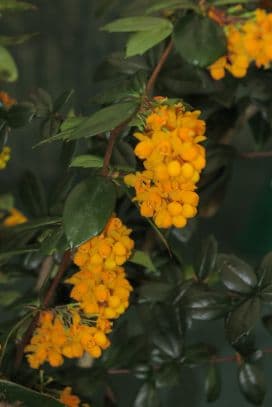
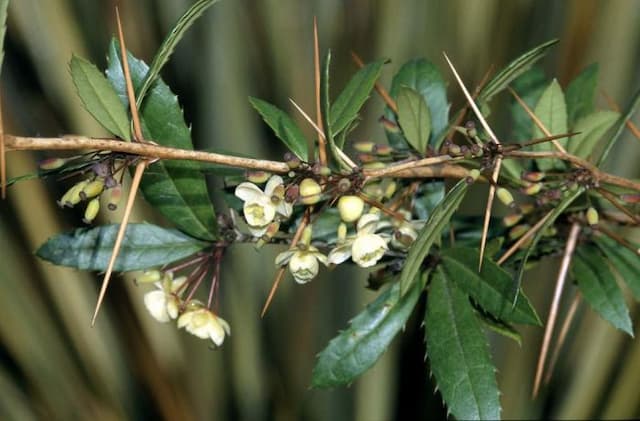
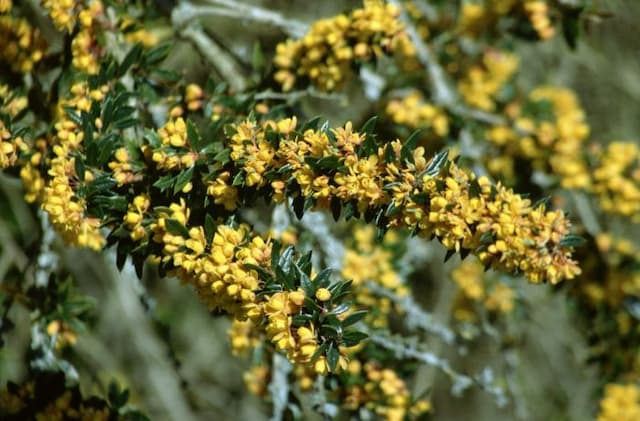
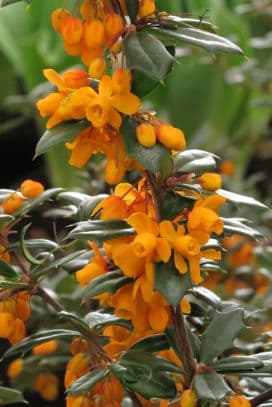
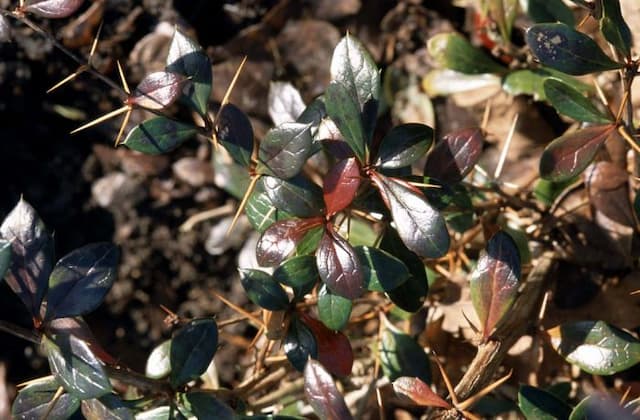


![Japanese barberry [Bonanza Gold]](/_next/image?url=https%3A%2F%2Fplants-admin.emdemapps.com%2Fimages%2Fplants%2F%2Fimages%2F604b5385e413f.png&w=640&q=75)
